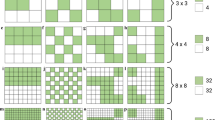Abstract
We investigate previously unreported phenomena that have a potentially significant impact on the design of surveillance monitoring programs for ecological systems. Ecological monitoring practitioners have long recognized that different species are differentially informative of a system’s dynamics, as codified in the well-known concepts of indicator or keystone species. Using a novel combination of analysis techniques from nonlinear dynamics, we describe marked variation among spatial sites in information content with respect to system dynamics in the entire region. We first observed these phenomena in a spatially extended predator–prey model, but we observed strikingly similar features in verified water-level data from a NOAA/NOS Great Lakes monitoring program. We suggest that these features may be widespread and the design of surveillance monitoring programs should reflect knowledge of their existence.
Similar content being viewed by others
References
Yoccoz, N., Nichols, J., Boulinier, T.: Monitoring of biological diversity in space and time. Trends Ecol. Evol. 16, 446–453 (2001)
Thompson, S.: Sampling. Wiley, New York (2002)
Nichols, J., Moniz, L., Nichols, J., Pecora, L., Cooch, E.: Assessing spatial coupling in complex population dynamics using mutual prediction and continuity statistics. Theor. Popul. Biol. 67, 9–21 (2005)
Jonzen, N., Rhodes, J.B., Possingham, H.P.: Trend detection in source-sink systems: when should sink habitats be monitored? Ecol. Appl. 15(1), 326–334 (2005)
Schreiber, T.: Measuring information transfer. Phys. Rev. Lett. 85, 462–464 (2000)
Fisher, R.: Theory of statistical estimation. Trans. Camb. Philos. Soc. 22, 700–725 (1925)
Kullback, S.: Information Theory and Statistics. Dover, Mineola, New York (1997)
Hartley, R.: Transmission of information. Bell Syst. Tech. J. 7, 535–563 (1928)
Shannon, C., Weaver, W.: The Mathematical Theory of Communication. University of Illinois Press, Chicago, IL (1949)
Fraser, A., Swinney, H.: Independent coordinates for strange attractors from mutual information. Phys. Rev., A. 33, 1134–1140 (1986)
Pecora, L., Carroll, T., Heagy, J.: Statistics for mathematical properties of maps between time series embeddings. Phys. Rev., E 52(4), 3420–3439 (1995)
Silverman, B.: Density estimation for Statistics and Data Analysis, Monographs on Statistics and Applied Probability. Chapman and Hall, London. Available online at http://www.doc.ic.ac.uk/~xh1/Reference/density-estimation/density-extimation-for-statistics-and-data-analysis.pdf (1986)
Kaiser, A., Schreiber, T.: Information transfer in continuous processes. Physica, D 166, 43–62 (2002)
Marschinski, R., Kantz, H.: Analysing the information flow between financial time series: an improved estimator for transfer entropy. Eur. Phys. J., B 30, 275–281 (2002)
Hjaltason, G.R., Samet, H.: Ranking in spatial databases. In: Engenhoffer, M.J., Herring J.R. (eds.) Proceedings of the 4th Symposium on Large Spatial Databases, vol. 951 of Lecture Notes in Computer Science, pp. 83–95. Springer, Berlin (1995)
Hunt, B., Ott, E., Yorke, J.A.: Generalized differentiable synchronization of chaos. Phys. Rev., E. 44, 4029–4034 (1997)
Pascual, M.: Diffusion-induced chaos in a spatial predator–prey system. Proc. R. Soc. B 25, 1–7 (1993)
NOAA/NOS: Verified Lake Level Data for the Great Lakes. http://www.glerl.noaa.gov/data/now/wlevels/levels.html (2005)
Bendat, J., Piersol, A.: Random Data: Analysis and Measurement Procedures. Wiley, New York (1986)
Pecora, L., Moniz, L., Nichols, J., Carroll, T.: A unified approach to attractor reconstruction. Chaos 17, 013110 (2007)
Sauer, T., Yorke, J.A., Casdagli, M.: Embedology. J. Stat. Phys. 65(3/4), 579–616 (1991)
Noon, B.: Conceptual issues in monitoring ecological resources. In: Busch, D., Trexler, J. (eds.) Monitoring Ecosystems, pp. 27–71. Island Press, Washington, DC (2003)
Bjornstad, O., Ims, R., Lambin, X.: Spatial population dynamics: analyzing patterms and processes of population synchrony. Trends Ecol. 14, 427–432 (1999)
Koenig, W.: Spatial autocorrelation of ecological phenomena. Trends Ecol. 14, 427–432 (1999)
Author information
Authors and Affiliations
Corresponding author
Rights and permissions
About this article
Cite this article
Moniz, L.J., Nichols, J.D. & Nichols, J.M. Mapping the Information Landscape: Discerning Peaks and Valleys for Ecological Monitoring. J Biol Phys 33, 171–181 (2007). https://doi.org/10.1007/s10867-007-9047-y
Received:
Accepted:
Published:
Issue Date:
DOI: https://doi.org/10.1007/s10867-007-9047-y




